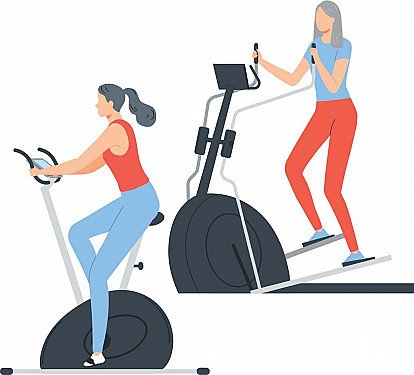The best exercises for your warm-up
Tailor a warm-up to the type of physical activity you'll be doing.
- Reviewed by Anthony L. Komaroff, MD, Editor in Chief, Harvard Health Letter; Editorial Advisory Board Member, Harvard Health Publishing
A warm-up is essential before a workout. Sometimes, just marching in place and moving your arms around for a few minutes is enough to prepare your body for what it's about to endure. At other times, it takes more work to get your body ready for activity. "Many people think that a warm-up before playing golf, pickleball, or tennis means taking a couple of practice swings with the club or racquet. In reality, it should include five to 10 minutes of warm-up activities," says Christina Ruggeri, a physical therapist specializing in sports medicine at Harvard-affiliated Spaulding Rehabilitation Hospital.
What does the warm-up do?
Warm-up activities accomplish several tasks:
- They get blood pumping, which sends oxygen and energy to your tissues and muscles, so they're ready for activity.
- They put muscles and joints through their range of motion, gently stretching them so they can accommodate broad movements.
- They prepare the joints for forward and backward movement, side-to-side movement, and rotation.
For moderate-intensity activity
The type of warm-up you need depends on your activity. For a strengthening routine or moderate-intensity activity (such as brisk walking or riding a bike on level ground), marching in place for a few minutes makes an effective warm-up. Swing your arms as you march.
"Alternating leg activity can quickly raise the heart rate, which is important in a warm-up," Ruggeri says. "Marching also works your leg and buttock muscles. The leg you lift works the hip flexor. Your stationary leg works the gluteal muscles [in the buttocks] and the quadriceps [in the thighs]."
Move of the month: Alternating hamstring curls
Photo by Michael Carroll |
For more intense activity
For vigorous physical activity, such as swimming or playing tennis, or for activity involving strenuous physical movements, such as golf, you'll need a more extensive warm-up. For example: "Golf requires that you swing your arms and turn your trunk. Tennis and pickleball require those movements, plus lateral shuffles. So you'll want to prepare the muscles for that," Ruggeri says.
One way to warm up is by practicing moves you'll perform later. "Do the movement repeatedly, in a slow and controlled manner, to allow the body to adjust to the activity," Ruggeri says. "For example, for tennis, stand in place and slowly perform a backhand swing to warm up the shoulder and core muscles."
Other warm-up activities to perform before vigorous exercise include marching in place, arm sweeps (sweeping your arms overhead), torso rotations (turning your torso left and then right), and the following moves.
Step-ups. Facing the lowest step in a staircase, take one full step up and then step back down. Repeat the exercise 10 times, take a break, then do another 10 step-ups. "This targets your quadriceps muscles when you step up, and your gluteal muscles when you step down. When you step up with one leg at a time, you also activate your core and back muscles to help keep your body upright," says Ruggeri.
Arm circles. Put your arms out to the sides and move them in circles of varying size (small, medium, and then large). Move them in forward circles for 30 seconds, then backward circles for 30 seconds. "This helps the shoulder muscles and the rotator cuff, a group of muscles and tendons at the shoulder," Ruggeri says. "The shoulder is the most mobile joint in the body, and these circles allow for the full range of shoulder movement."
Air punches. Punch the air in front of you, alternating right and left arms, for 30 seconds. Then do 30 seconds of cross-body punches: punch your right hand to the left, and then your left hand to the right. Try some uppercuts, too (punching upward). "Punches increase your heart rate and get more blood flowing through the arm," Ruggeri says.
Stretching after activity
After the warm-up, do your workout. Finish the activity with stretches — gently holding each stretch for about 30 to 60 seconds. Ruggeri recommends stretching the shoulders, buttocks and hip muscles, upper leg muscles (the hamstrings and quadriceps), and calves. This will keep muscles long and supple, and ready to respond the next time you call on them for a workout or everyday activity.
About the Author

Heidi Godman, Executive Editor, Harvard Health Letter
About the Reviewer

Anthony L. Komaroff, MD, Editor in Chief, Harvard Health Letter; Editorial Advisory Board Member, Harvard Health Publishing
Disclaimer:
As a service to our readers, Harvard Health Publishing provides access to our library of archived content. Please note the date of last review or update on all articles.
No content on this site, regardless of date, should ever be used as a substitute for direct medical advice from your doctor or other qualified clinician.











 Stand with your feet hip-width apart. Bend your left knee to bring your left heel toward your buttocks as you balance on your right leg. Immediately return to the starting position. Repeat with your right leg. Continue this left-right sequence for a total of 10 times on each leg. Let your arms swing forward and back as you move.
Stand with your feet hip-width apart. Bend your left knee to bring your left heel toward your buttocks as you balance on your right leg. Immediately return to the starting position. Repeat with your right leg. Continue this left-right sequence for a total of 10 times on each leg. Let your arms swing forward and back as you move.




